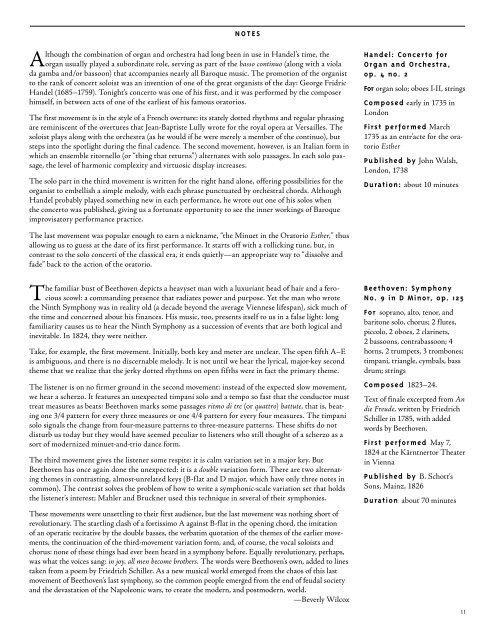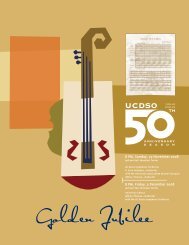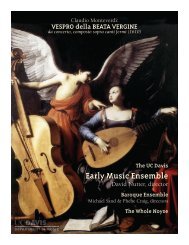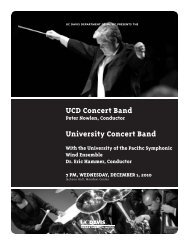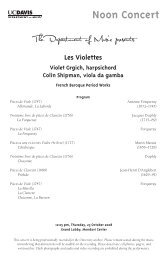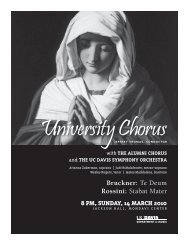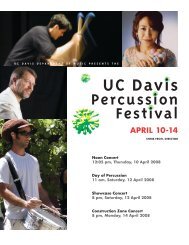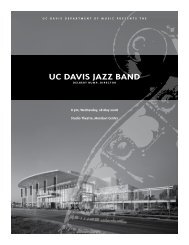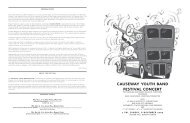to get the file - UC Davis: Department of Music - University of ...
to get the file - UC Davis: Department of Music - University of ...
to get the file - UC Davis: Department of Music - University of ...
You also want an ePaper? Increase the reach of your titles
YUMPU automatically turns print PDFs into web optimized ePapers that Google loves.
n o t e s<br />
Although <strong>the</strong> combination <strong>of</strong> organ and orchestra had long been in use in Handel’s time, <strong>the</strong><br />
organ usually played a subordinate role, serving as part <strong>of</strong> <strong>the</strong> basso continuo (along with a viola<br />
da gamba and/or bassoon) that accompanies nearly all Baroque music. The promotion <strong>of</strong> <strong>the</strong> organist<br />
<strong>to</strong> <strong>the</strong> rank <strong>of</strong> concert soloist was an invention <strong>of</strong> one <strong>of</strong> <strong>the</strong> great organists <strong>of</strong> <strong>the</strong> day: George Fridric<br />
Handel ( 685– 759). Tonight’s concer<strong>to</strong> was one <strong>of</strong> his first, and it was performed by <strong>the</strong> composer<br />
himself, in between acts <strong>of</strong> one <strong>of</strong> <strong>the</strong> earliest <strong>of</strong> his famous ora<strong>to</strong>rios.<br />
The first movement is in <strong>the</strong> style <strong>of</strong> a French overture: its stately dotted rhythms and regular phrasing<br />
are reminiscent <strong>of</strong> <strong>the</strong> overtures that Jean-Baptiste Lully wrote for <strong>the</strong> royal opera at Versailles. The<br />
soloist plays along with <strong>the</strong> orchestra (as he would if he were merely a member <strong>of</strong> <strong>the</strong> continuo), but<br />
steps in<strong>to</strong> <strong>the</strong> spotlight during <strong>the</strong> final cadence. The second movement, however, is an Italian form in<br />
which an ensemble ri<strong>to</strong>rnello (or “thing that returns”) alternates with solo passages. In each solo passage,<br />
<strong>the</strong> level <strong>of</strong> harmonic complexity and virtuosic display increases.<br />
The solo part in <strong>the</strong> third movement is written for <strong>the</strong> right hand alone, <strong>of</strong>fering possibilities for <strong>the</strong><br />
organist <strong>to</strong> embellish a simple melody, with each phrase punctuated by orchestral chords. Although<br />
Handel probably played something new in each performance, he wrote out one <strong>of</strong> his solos when<br />
<strong>the</strong> concer<strong>to</strong> was published, giving us a fortunate opportunity <strong>to</strong> see <strong>the</strong> inner workings <strong>of</strong> Baroque<br />
improvisa<strong>to</strong>ry performance practice.<br />
The last movement was popular enough <strong>to</strong> earn a nickname, “<strong>the</strong> Minuet in <strong>the</strong> Ora<strong>to</strong>rio Es<strong>the</strong>r,” thus<br />
allowing us <strong>to</strong> guess at <strong>the</strong> date <strong>of</strong> its first performance. It starts <strong>of</strong>f with a rollicking tune, but, in<br />
contrast <strong>to</strong> <strong>the</strong> solo concerti <strong>of</strong> <strong>the</strong> classical era, it ends quietly—an appropriate way <strong>to</strong> “dissolve and<br />
fade” back <strong>to</strong> <strong>the</strong> action <strong>of</strong> <strong>the</strong> ora<strong>to</strong>rio.<br />
The familiar bust <strong>of</strong> Beethoven depicts a heavyset man with a luxuriant head <strong>of</strong> hair and a ferocious<br />
scowl: a commanding presence that radiates power and purpose. Yet <strong>the</strong> man who wrote<br />
<strong>the</strong> Ninth Symphony was in reality old (a decade beyond <strong>the</strong> average Viennese lifespan), sick much <strong>of</strong><br />
<strong>the</strong> time and concerned about his finances. His music, <strong>to</strong>o, presents itself <strong>to</strong> us in a false light: long<br />
familiarity causes us <strong>to</strong> hear <strong>the</strong> Ninth Symphony as a succession <strong>of</strong> events that are both logical and<br />
inevitable. In 8 4, <strong>the</strong>y were nei<strong>the</strong>r.<br />
Take, for example, <strong>the</strong> first movement. Initially, both key and meter are unclear. The open fifth A–E<br />
is ambiguous, and <strong>the</strong>re is no discernable melody. It is not until we hear <strong>the</strong> lyrical, major-key second<br />
<strong>the</strong>me that we realize that <strong>the</strong> jerky dotted rhythms on open fifths were in fact <strong>the</strong> primary <strong>the</strong>me.<br />
The listener is on no firmer ground in <strong>the</strong> second movement: instead <strong>of</strong> <strong>the</strong> expected slow movement,<br />
we hear a scherzo. It features an unexpected timpani solo and a tempo so fast that <strong>the</strong> conduc<strong>to</strong>r must<br />
treat measures as beats: Beethoven marks some passages ritmo di tre (or quattro) battute, that is, beating<br />
one 3/4 pattern for every three measures or one 4/4 pattern for every four measures. The timpani<br />
solo signals <strong>the</strong> change from four-measure patterns <strong>to</strong> three-measure patterns. These shifts do not<br />
disturb us <strong>to</strong>day but <strong>the</strong>y would have seemed peculiar <strong>to</strong> listeners who still thought <strong>of</strong> a scherzo as a<br />
sort <strong>of</strong> modernized minuet-and-trio dance form.<br />
The third movement gives <strong>the</strong> listener some respite: it is calm variation set in a major key. But<br />
Beethoven has once again done <strong>the</strong> unexpected: it is a double variation form. There are two alternating<br />
<strong>the</strong>mes in contrasting, almost-unrelated keys (B-flat and D major, which have only three notes in<br />
common). The contrast solves <strong>the</strong> problem <strong>of</strong> how <strong>to</strong> write a symphonic-scale variation set that holds<br />
<strong>the</strong> listener’s interest; Mahler and Bruckner used this technique in several <strong>of</strong> <strong>the</strong>ir symphonies.<br />
These movements were unsettling <strong>to</strong> <strong>the</strong>ir first audience, but <strong>the</strong> last movement was nothing short <strong>of</strong><br />
revolutionary. The startling clash <strong>of</strong> a fortissimo A against B-flat in <strong>the</strong> opening chord, <strong>the</strong> imitation<br />
<strong>of</strong> an operatic recitative by <strong>the</strong> double basses, <strong>the</strong> verbatim quotation <strong>of</strong> <strong>the</strong> <strong>the</strong>mes <strong>of</strong> <strong>the</strong> earlier movements,<br />
<strong>the</strong> continuation <strong>of</strong> <strong>the</strong> third-movement variation form, and, <strong>of</strong> course, <strong>the</strong> vocal soloists and<br />
chorus: none <strong>of</strong> <strong>the</strong>se things had ever been heard in a symphony before. Equally revolutionary, perhaps,<br />
was what <strong>the</strong> voices sang: in joy, all men become bro<strong>the</strong>rs. The words were Beethoven’s own, added <strong>to</strong> lines<br />
taken from a poem by Friedrich Schiller. As a new musical world emerged from <strong>the</strong> chaos <strong>of</strong> this last<br />
movement <strong>of</strong> Beethoven’s last symphony, so <strong>the</strong> common people emerged from <strong>the</strong> end <strong>of</strong> feudal society<br />
and <strong>the</strong> devastation <strong>of</strong> <strong>the</strong> Napoleonic wars, <strong>to</strong> create <strong>the</strong> modern, and postmodern, world.<br />
—Beverly Wilcox<br />
handel: concer <strong>to</strong> for<br />
organ and orchestra,<br />
op. 4 no. 2<br />
for organ solo; oboes I-II, strings<br />
composed early in 735 in<br />
London<br />
first per formed March<br />
735 as an entr’acte for <strong>the</strong> ora<strong>to</strong>rio<br />
Es<strong>the</strong>r<br />
published by John Walsh,<br />
London, 738<br />
Duration: about 0 minutes<br />
Beethoven: symphony<br />
no. 9 in D minor, op. 125<br />
for soprano, al<strong>to</strong>, tenor, and<br />
bari<strong>to</strong>ne solo, chorus; flutes,<br />
piccolo, oboes, clarinets,<br />
bassoons, contrabassoon; 4<br />
horns, trumpets, 3 trombones;<br />
timpani, triangle, cymbals, bass<br />
drum; strings<br />
composed 8 3– 4.<br />
Text <strong>of</strong> finale excerpted from An<br />
die Freude, written by Friedrich<br />
Schiller in 785, with added<br />
words by Beethoven.<br />
first per formed May 7,<br />
8 4 at <strong>the</strong> Kärntner<strong>to</strong>r Theater<br />
in Vienna<br />
published by B. Schott’s<br />
Sons, Mainz, 8 6<br />
Duration about 70 minutes


